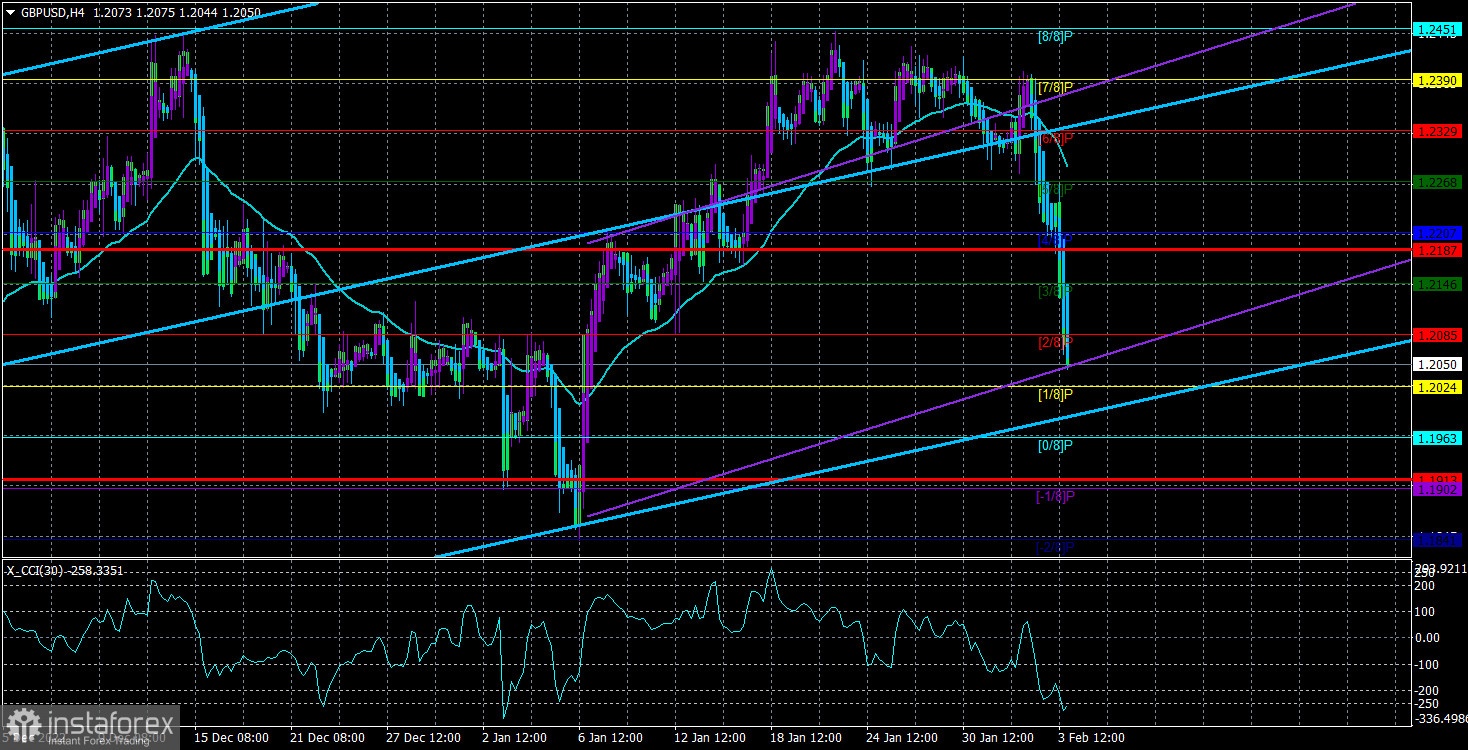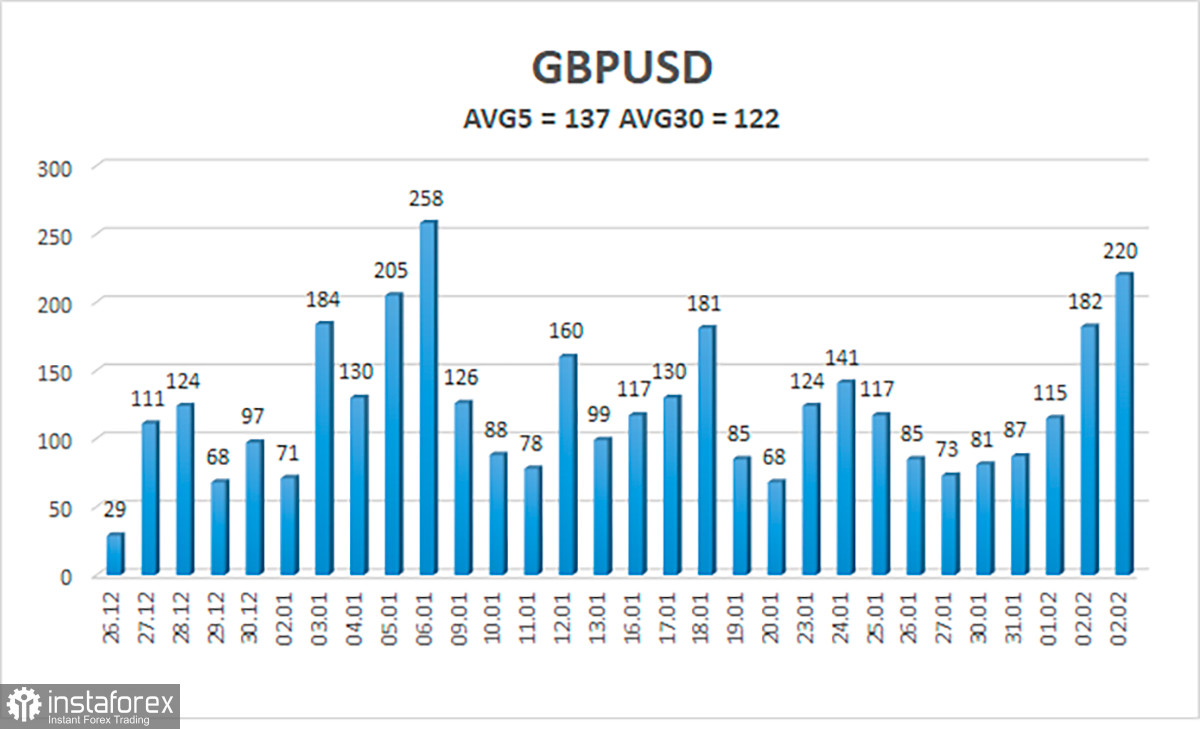
On Friday, the GBP/USD currency pair fell by around 200 points. As we've already mentioned, positive macroeconomic indicators from overseas led to the decline of the pound (or, rather, the rise of the dollar). As a result, the movement of the pound was entirely logical and reasonable. As can be seen in the image above, the "double top" formation has finally developed, and it is now entirely conceivable to anticipate a collapse to the prior local minimum. As previously stated, we expect the pair to undergo another round of negative correction following its rapid increase of 2100 points. Recall that the Bank of England increased interest rates by another 0.5% to 4% last week. However, most market participants anticipate a new reduction in the rate of tightening next month, followed by a complete rejection of the rate hike. As a result, the "rate factor" is rapidly losing its ability to sustain the pound. Recall that the dollar started to weaken last fall when the US inflation rate started to decrease and there were rumors that the Fed would start to ease off on the pace of tightening. Except for a drop in inflation, the UK is currently experiencing roughly the same situation. Formally, it is declining, but only slowly.
Despite what Andrew Bailey claims, the British regulator does not have the option of raising rates "until the bitter end." Even at 4%, inflation is not significantly decreasing. As a result, it must be raised to a minimum of 5.5–6%. BA won't be able to afford such a luxury because a far deeper recession than anticipated could occur in the economy. To balance between inflation and recession, the regulator is likely to do so. To lower inflation as much as possible and prevent a major recession, they will attempt to raise the rate as much as possible. The target for the next three to five years is to get inflation down to 2%, which is not likely to happen in the near future. As a result, everything now comes down to BA raising the rate gradually before refusing to tighten. For the pound, this is bad news.
The week's most important report is on UK GDP.
This week in the UK, there won't be many significant events, but there will be some. On Monday, a secondary index of economic activity in the construction industry will be made public. Reports on the GDP and industrial production are due on Friday. The market will pay attention to the GDP data. Forecasts suggest that the GDP will expand between 0.0 and 0.1% quarterly and between 0.02 and 0.4% yearly. Despite being at extremely low levels, these are nonetheless positive values. The UK economy contracted by 0.3% in the most recent quarter. The fourth-quarter GDP decline will contribute to the pound's further decline against the dollar.
With a speech by Jerome Powell on Tuesday, everything will get underway in the United States. We think that this event is also incidental because Powell had last week's Fed meeting and was free to tell the markets whatever he wanted to. He did just that. Therefore, it is not necessary to anticipate hearing anything truly novel from him on Tuesday. The standard report on unemployment benefit applications will be released on Thursday, and the standard University of Michigan consumer confidence index will be released on Friday. 90% of the time, the movement of the pair will not be influenced by macroeconomics or the "foundation" this week. Trading must therefore begin primarily with "technology". An upward correction following a two-day decline is very likely, but it might not even start on Monday. Instead, it might start on Tuesday. Strong fundamentals from the previous week may cause an inertial fall of the pair for an additional one to two days. Volatility should decline in either event. The quotes on the 24-hour TF dropped below the crucial line, which is a huge help for the trend to go south.

Over the previous five trading days, the GBP/USD pair has averaged 137 points of volatility. This figure is "high" for the dollar/pound exchange rate. As a result, on Monday, February 4, we anticipate movement that is constrained by the levels of 1.1913 and 1.2187. A round of upward corrective is indicated by the Heiken Ashi indicator's upward reversal.
Nearest levels of support
S1 – 1.2024
S2 – 1.1963
S3 – 1.1902
Nearest levels of resistance
R1 – 1.2085
R2 – 1.2146
R3 – 1.2207
Trading Suggestions:
The GBP/USD pair is still falling sharply during a 4-hour period. Therefore, until the Heiken Ashi indicator turns up, it is possible to hold short positions with targets of 1.1963 and 1.1913. If the price is fixed above the moving average line, long trades can be opened with targets of 1.2329 and 1.2390.
Explanations for the illustrations:
Determine the present trend with the use of linear regression channels. The trend is now strong if they are both moving in the same direction.
Moving average line (settings 20.0, smoothed): This indicator identifies the current short-term trend and the trading direction.
Murray levels serve as the starting point for adjustments and movements.
Based on current volatility indicators, volatility levels (red lines) represent the expected price channel in which the pair will trade the following day.
A trend reversal in the opposite direction is imminent when the CCI indicator crosses into the overbought (above +250) or oversold (below -250) zones.
 English
English 
 Русский
Русский Bahasa Indonesia
Bahasa Indonesia Bahasa Malay
Bahasa Malay ไทย
ไทย Español
Español Deutsch
Deutsch Български
Български Français
Français Tiếng Việt
Tiếng Việt 中文
中文 বাংলা
বাংলা हिन्दी
हिन्दी Čeština
Čeština Українська
Українська Română
Română

